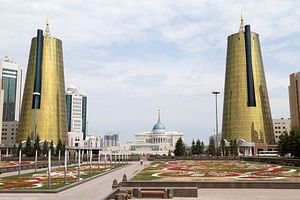Over the course of a week, Japanese Prime Minster Shinzo Abe traveled to Mongolia, Turkmenistan, Tajikistan, Uzbekistan, Kyrgyzstan, and Kazakhstan. The five-hour Mongolia stop that kicked off the trip was unique, as it touched on the North Korean abductees issue (which remains an important political topic for Tokyo). But the primary motivation for Abe’s whirlwind Central Asian tour is to push for Japan’s economic interests and counter the expansion of Chinese influence in the region by strengthening economic and energy-related bilateral cooperation with each of the five nations.
Before he departed, Abe spoke at Haneda International Airport to explain the reasoning behind the trip: “Mongolia and Central Asia are located at the heart of Asia and make up a geopolitically very important area serving as an East-West connection point… As all of the countries are seeking high-quality infrastructure, Japan has a role to play. Together with the Japanese business leaders who will accompany us, we’re hoping to dramatically strengthen ties with each of these nations.”
It has been nine years since the last Japanese prime minister visited Central Asia; that and the fact that Abe is the first Japanese prime minister to visit Turkmenistan, Tajikistan, or Kyrgyzstan is, of course, a reflection of the impact of globalization, but it’s also a demonstration of Japan’s unprecedented level of interest in the region.
During Abe’s trip, Japan dispensed millions to trillions of yen in aid and economic cooperation at each destination. Japan plans not only to give, but to gain as well–Abe said he sees economic potential worth more than 3 trillion yen ($24 billion) in infrastructure and other projects in Central Asia. Fifty business leaders accompanied Abe in search of such opportunities.
In Turkmenistan, deals were reached for Japan to provide at least 2.2 trillion yen ($18 billion) in assistance to build social infrastructure, such as natural gas-processing plants, power generation facilities, and other facilities. Turkmen President Gurbanguly Berdimuhamedov also expressed hope that Japanese companies will get involved in constructing natural gas plants and transportation infrastructure. Turkmenistan hopes to add more value to the gas it produces; its natural gas is primarily exported to China through pipelines.
On Abe’s next stop, Tajikistan, he pledged 900 million yen ($7.5 million) in grant aid to improve water facilities and agricultural productivity. Japan also agreed to increase its support for Tajikistan to strengthen border control along its 1,400 kilometer border with Afghanistan, to prevent terrorists and drugs from entering the country.
Official development assistance of 12 billion yen ($99 million) in loans and 700 million ($5.8 million) in grant aid was pledged to Uzbekistan. This financial assistance will be used to build power facilities and enhance medical-related equipment.
In Kyrgyzstan, Japan agreed to resume yen loans, which had been frozen for 16 years. Yen loans were frozen after Kyrgyzstan began falling behind schedule in 1999. Japan will now lend about 12 billion yen ($99 million) to help the country build a highway connecting the capital with a southern city.
Cooperation took a different approach in Kazakhstan, where Abe offered to support building nuclear power plants. Abe and Kazakh President Nursultan Nazarbayev also committed to cooperate on nuclear disarmament, nonproliferation, and facilitate the enactment of the Comprehensive Test Ban Treaty. Japan is the only nation to suffer an atomic bombing, while Kazakhstan experienced hundreds of nuclear tests while it was a part of the Soviet Union.
It is a marriage of convenience between Japan and these five Central Asian nations. The Central Asian nations are currently best known for their natural resources, most notably oil and natural gas but also including uranium, rare metals, and gold. But because of decreasing prices for natural resources, these five nations are trying to diversify their industrial base. This is where Japan can step in, because of Japan’s experience and know-how exporting social infrastructure. In fact, Abe’s economic growth strategy promotes expanding infrastructure exports.
Japan is entering an already-crowded competition for influence. As former members of the Soviet Union, the five Central Asian nations all maintain close ties with Russia. More recently, China has been cultivating strong political, financial and economic ties with each of these five nations. China’s “One Belt, One Road” initiative, the Shanghai Cooperation Organization, and the Asian Infrastructure Investment Bank are three of the flashiest ways China is increasing its regional presence. It is this development, more so than Russia’s long-standing engagement, that is prompting the current Japanese response. Asahi Shimbun cites a high-ranking Foreign Ministry official as saying, “With China increasing its presence, it will be important for Japan to show a posture of wanting to be engaged in the development of this area.” Instead of waiting for Central Asian leaders to visit Japan, Abe has made his interest clear by visiting Central Asia.
Central Asian nations, too, have an interest in bringing Japanese influence in. As Yomiuri Shimbun comments, Japan can act as a “safety valve” – more trade with and investment from Japan can reduce their reliance on China and Russia. The Central Asian nations also may want a hedge against China, a role Japan can fill.
After concluding this trip successfully, the next big moment in Japan-Central Asian relations will be the foreign ministers’ meeting next year. The meeting, “Central Asia plus Japan” initiative, will be hosted in Turkmenistan.

































